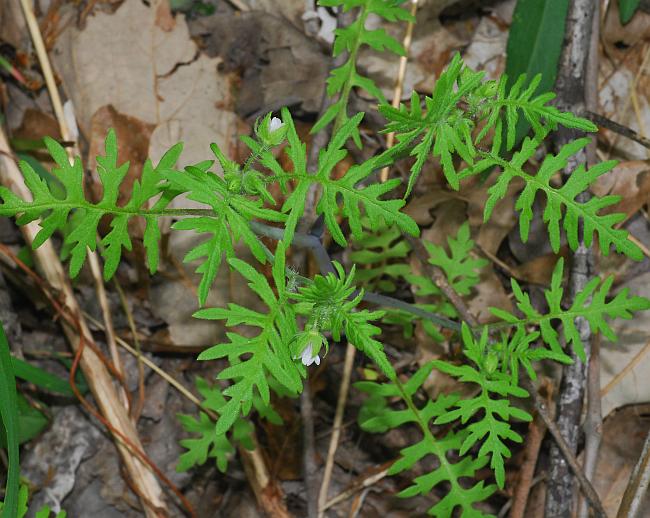Ellisia nyctelea (L.) L.
Aunt Lucy

Native
CC = 1
CW = 3
MOC = 69
© SRTurner
Ellisia nyctelea (L.) L.Aunt Lucy | |
 |
Native CC = 1 CW = 3 MOC = 69 |
© SRTurner |
|
Family - Hydrophyllaceae Habit - Annual forb with slender taproot. Stems - Spreading to loosely ascending or ascending from a spreading base, to 40 cm, fleshy, hollow, glaucous, usually sparsely pubescent with stiff, straight, spreading to downward-angled, somewhat pustular-based hairs, occasionally also with sparse, fine curved, softer hairs.
Leaves - Alternate, petiolate. Basal leaves often withered at flowering, similar to the lower stem leaves. Stem leaves mostly alternate (often opposite toward the stem base), the petiole to 2 cm long, mostly shorter than the blade, stiffly hairy toward the base. Leaf blades 2-6 cm long, oblong-elliptic in outline, deeply pinnately lobed, the rachis narrowly winged, the pinnae 7-13, mostly narrowly oblong, entire or more commonly with 1-3 pairs of coarse teeth or triangular lobes, angled or tapered to a sharply pointed tip, truncate and attached broadly at the base, the surfaces sparsely to moderately pubescent with stiff, straight, somewhat pustular-based hairs, sometimes only along the veins, the upper surface not appearing mottled, the margins ciliate.
Inflorescence - Single flowers opposite the upper leaves, occasionally axillary or paired at branch tips. Pedicels 5-10 mm long at flowering, becoming elongated to 2-6 cm at fruiting, stiffly hairy.
Flowers - Calyces deeply 5-lobed, 4-6 mm long at flowering, becoming enlarged to 7-10 mm at fruiting, lacking appendages, the lobes narrowly triangular (becoming broader at fruiting), sharply pointed at the tip, the surfaces and margins sparsely to moderately and stiffly hairy. Corollas tubular, cylindric, 5-8 mm long, narrowly bell-shaped to nearly funnel-shaped, glabrous externally and internally, 5-lobed, white, often pale pinkish-or bluish-tinged, occasionally with blue nerves or spots. Stamens 5, alternating with the corolla lobes, not exserted, the filaments attached at the base of the corolla tube, glabrous or nearly so, each with a pair of minute scales at the base. Ovary 1-locular, covered with long white bristles, superior, subtended by a ring of nectaries. Style not exserted, divided to about the midpoint.
Fruit - Fruits 5-6 mm long, globose, sparsely to moderately hairy, at least toward the tip, mostly 4-seeded. Seeds 2-3 mm long, globose, the surface with a fine network of ridges, dark brown.
Flowering - April - June. Habitat - Bottomland and mesic forests, bases and ledges of bluffs, streambanks, crop fields, gardens, roadsides, and moist, shaded, disturbed areas. Origin - Native to the U.S. Lookalikes - Flowers resemble those of Phacelia ranunculacea, but the leaves are completely different. Other info. - This little species is found across most of Missouri, less commonly in the southeastern corner of the state. It is easily recognized by the distinctively shaped leaves and small white flowers, borne on low, branching plants in moist, shaded areas. Photographs taken at Eagle Bluffs Conservation Area, Boone County, MO., 4-18-04 (DETenaglia); also along the Katy Trail southeast of Dutzow, Warren County, MO, 4-25-2015, near St. Albans, Franklin County, MO, 4-28-2015, Faust County Park, St. Louis County, MO, 4-30-2019, and at Klondike County Park, St. Charles County, MO, 5-25-2020 (SRTurner). |